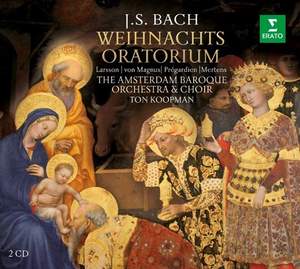“Koopman allows the music to flow and breathe naturally, and constantly demonstrates his keen sense for tantalising the senses with tonal colours.” (Rondo)
Bach’s Christmas Oratorio is the musical embodiment of the whole period of festive celebrations associated with Christmas. Every year it is performed at concerts throughout the country. Mostly the first three parts are played one after the other in some cases it is even possible to hear all six parts in succession.
Yet Bach himself never imagined the work being performed in this way. According to the title-page of the 1734 libretto, the “oratorio was performed over Christmas in the two main churches in Leipzig”. The first performance extended over a period of thirteen days from Christmas Day to the Feast of the Epiphany. It comprises six self-contained sections, each modelled on a sacred cantata, but all six parts fit together to form a cycle, often being related to each other in terms of their tonality and orchestral forces. Timpani, trumpets and a festive D major are characteristics not only of the opening chorus of Part One, “Jauchzet, frohlocket”, but also of the final chorus of Part Six, “Nun seid ihr wohl gerochen”. Together, they provide a magnificent framework for the piece.
The Christmas Oratorio is instantly memorable thanks to its tuneful melodies and the intelligibility of its narrative, and yet it rests on an elaborate design. Drawing on all his resources, Bach tells the story of Jesus’s birth (Part One), the experiences of the shepherds (Parts Two and Three), the act of naming Him (Part Four) and the Three Wise Men from the East (Parts Five and Six). The words are drawn from the Gospels of St Luke and St Matthew, but there are also other textual layers involving the chorales and passages of free verse that are also clearly demarcated from a musical point of view. The underlying structure also serves to invest the work with increasing depth: each part begins with an opening chorus followed by the biblical narrative in the form of secco recitatives involving no more than chordal writing for the continuo group. This is frequently followed by an instrumentally accompanied recitative that culminates in a prayer-like aria. The congregation finally takes up this prayer in the concluding chorale.
As was usual at the time – copyright laws did not exist in Bach’s day – the composer drew on his own back catalogue, a good quarter of the numbers that make up the oratorio being based on existing material – mostly two secular cantatas, BWV214 Tönet, ihr Pauken! Erschallet, Trompeten!, which is the source of the opening chorus, “Jauchzet, frohlocket”, and BWV213 Herkules auf dem Scheideweg. But Bach did not limit himself to setting new words to existing music. Instead he made often substantial changes in order to align the two, working closely with his librettist, who is believed to have been Christian Friedrich Henrici, otherwise known as Picander. Sometimes he decided against simply taking over the existing music and wrote a new movement, as he did with the opening chorus of Part Five, “Ehre sei dir, Gott, gesungen”.
Only one of the arias is new: in “Schließe, mein Herze” in Part Three, the alto soloist sings Mary’s prayer after meeting the shepherds, her vocal line playfully intertwining with the solo violin. This is one of the most intimate moments in the entire oratorio and finds Bach’s melodic invention supremely inspired – a superb example of his mature compositional style during his years in Leipzig.



